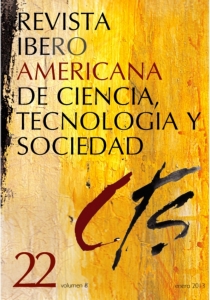Las dos revoluciones de Thomas S. Kuhn
DOI:
https://doi.org/10.52712/issn.1850-0013-664Palabras clave:
revolución científica, perspectiva relacional, revolución específicaResumen
En este artículo se propone abordar un análisis del libro La Estructura de las Revoluciones Científicas desde una perspectiva relacional que tome en cuenta el conjunto de posiciones y trayectorias de los productores de ideas en el campo intelectual, así como los esfuerzos por dar primacía a unas determinadas ideas, en determinados contextos históricos. Un primer acercamiento muestra que ese libro significó, por un lado, una revolución específica en los ámbitos cultivados (universitarios) de los Estados Unidos de Norteamérica en torno al año clave de 1968, pero, por otro lado, constituyó una síntesis extraordinaria de diversas ideas que venían siendo planteadas desde hacía varias décadas por varias escuelas de pensamiento europeas, por lo que resulta “revolucionaria” también desde un punto de vista general.
Descargas
Citas
BARANGER, D. (2004): Epistemología y metodología en la obra de Pierre Bourdieu, Buenos Aires, Prometeo Libros.
BOURDIEU, P. (1975): “La spécificité du champ scientifique et les conditions sociales du progrès de la raison”, Sociologie et sociétés, vol. 7, n° 1, pp. 91-118.
BOURDIEU, P. (2003): El oficio de científico. Ciencia de la ciencia y reflexividad, Barcelona, Anagrama.
BOURDIEU, P. (2008): Homo academicus, Buenos Aires, Argentina, Siglo XXI.
BOURDIEU, P, PASSERON, J. C y CHAMBOREDON Jean-Claude Chamboredon, (1979), El oficio de sociólogo, México, Siglo XXI.
CASSIRER, E. (1923/1910): Substance and function, Chicago, The Open Court Publishing Company.
CHAMPAGNE, P., PINTO, l. y SAPIRO, G. (2007): Pierre Bourdieu, sociólogo, Buenos Aires, Nueva Visión.
COMPLETE DICTIONARY OF SCIENTIFIC BIOGRAPHY (2008): “Kuhn, Thomas Samuel”. Disponible en: http://www.encyclopedia.com/doc/1G2-2830905834.html.
ENCREVE, P. y LAGRAVE, R. M. (2003) : Travailler avec Bourdieu,París, Champs- Flammarion.
GINGRAS, Y. (2010) : Propos sur les sciences,París, Raisons d’agir.
HACKING, I. (2012): “Introductory essay”, The Structure of Scientific Revolutions, 50th anniversary edition, University of Chicago Press.
HORGAN, J. (1991): “Profile: Reluctant Revolutionary: Thomas S. Kuhn unleashed ‘paradigm” on the world”, Scientific American,pp. 40-49.
KUHN, T. S. (1971): La Estructura de las Revoluciones Científicas,México, FCE.
KUHN, T. S. (1975): “Tradition mathématique et tradition expérimentale dans le développement de la physique”, Annales. Économies, Sociétés, Civilisations. 30e année, nº 5, pp. 975-998.
KUHN, T. S. (1983): La tensión esencial, México, FCE.
LORENZANO, C. (2002): “Los ancestros de Thomas Kuhn (Homenaje a Ludwik Fleck)”. Disponible en: http://www.clorenzano.com.ar/epistemologia/fleck.pdf.
MÜLLER-ARMACK, A. (1967): Genealogía de los estilos económicos, México, FCE.
PÉREZ TAMAYO, R. (2012): La revolución científica, México, FCE.
PINTO, L. (2002): Pierre Bourdieu y la teoría del mundo social,México. Siglo XXI.
RINGER, F. K. (2009): “Hacia una historia social comparativa del conocimiento”, en J. Schriewer y H. Kaelble: La comparación en las ciencias sociales e históricas, Barcelona, Octaedro, pp. 197-214.
SANDOVAL ARAGÓN, S. L. (2012): El economista y el sociólogo. Pensamiento relacional como paradigma”, Economía, teoría y práctica,nº 37, segundo semestre, México, (en prensa).
WACQUANT, L. y BOURDIEU, P. (2005) : Una invitación a la sociología reflexiva, Buenos Aires, Argentina, Siglo XXI.
Descargas
Publicado
Cómo citar
Número
Sección
Licencia
Derechos de autor 2024 CC Attribution 4.0

Esta obra está bajo una licencia internacional Creative Commons Atribución 4.0.
Todos los números de CTS y sus artículos individuales están bajo una licencia CC-BY.
Desde 2007, CTS proporciona un acceso libre, abierto y gratuito a todos sus contenidos, incluidos el archivo completo de su edición cuatrimestral y los diferentes productos presentados en su plataforma electrónica. Esta decisión se sustenta en la creencia de que ofrecer un acceso libre a los materiales publicados ayuda a un mayor y mejor intercambio del conocimiento.
A su vez, para el caso de su edición cuatrimestral, la revista permite a los repositorios institucionales y temáticos, así como también a las web personales, el auto-archivo de los artículos en su versión post-print o versión editorial, inmediatamente después de la publicación de la versión definitiva de cada número y bajo la condición de que se incorpore al auto-archivo un enlace a la fuente original.











